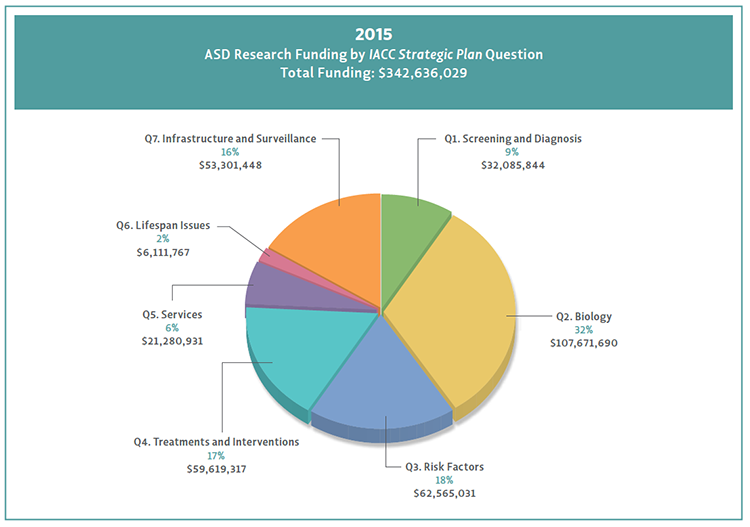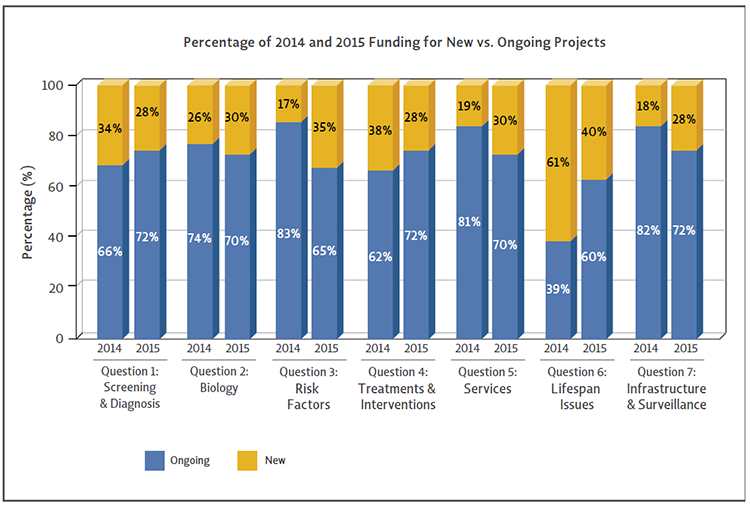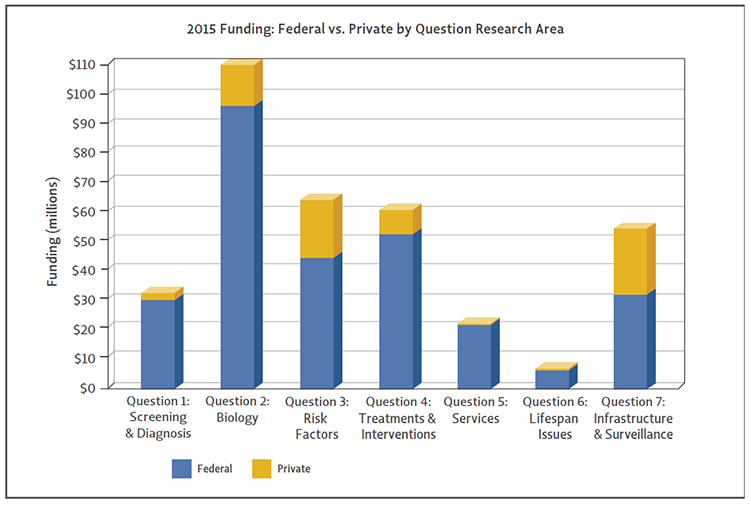Portfolio Analysis Report
IACC Autism Spectrum Disorder Research
2014-2015
What areas of ASD research were funded in 2014 and 2015?
To better understand what areas of research were funded in 2014 and 2015, projects were aligned with the corresponding questions in the 2011 IACC Strategic Plan. Figure 9 and Figure 10 illustrate the breakdown of the research funding per each of the Strategic Plan’s seven questions, which are related to Screening and Diagnosis (Q1), Biology (Q2), Risk Factors (Q3), Treatments and Interventions (Q4), Services (Q5), Lifespan Issues (Q6), and Infrastructure and Surveillance (Q7). Identifying how current research investments correspond to the Strategic Plan provides an understanding of how funders have directed investments across each of the priority areas identified by the IACC, as well as an indication of which areas are well-supported versus those that may need additional attention or development.
Figure 9. Topic areas are defined by each question in the IACC Strategic Plan. The seven questions of the Strategic Plan are represented in the clockwise direction, beginning with Screening and Diagnosis (Question 1) and ending with Infrastructure and Surveillance (Question 7).
Figure 10. The seven questions of the Strategic Plan are represented in the clockwise direction, beginning with Screening and Diagnosis (Question 1) and ending with Infrastructure and Surveillance (Question 7).
ASD research funding in 2014 and 2015 supported projects relevant to all seven of the critical questions in the IACC Strategic Plan for ASD Research. As in previous years, the largest portion of funding addressed the underlying biology (Question 2) of ASD (32% in 2014 and 2015). In 2014, this was followed by research into treatments and interventions (Question 4) for ASD (20%), including behavioral therapies, pharmacological treatments, and technology-based interventions. Question 3, research aimed at identifying potential causes and risk factors for the disorder, followed closely with 16% of total funding in 2014. However, in 2015, Question 4 and Question 3 exchanged rankings; there was a greater investment in research related to Question 3 (18%), which became the second largest portion of funding, while Question 4 was the third largest portion of funding with 17% of funding. The proportion of investment in research infrastructure and surveillance (Question 7) stayed relatively the same as in previous years (14% in 2014; 16% in 2015). Research to improve screening and diagnosis (Question 1) of ASD stayed relatively the same with 10% of research funding in 2014 and 9% in 2015. Research focused on services (Question 5) and lifespan issues (Question 6) remained the smallest areas of funding. Question 5 was 6% of ASD research funding in 2014 and 2015 and Question 6 was 2% of funding for both years. In both 2014 and 2015, the percentages of funding for each question were similar to those seen in 2013.
When the number of projects that align with each question, as opposed to the total funding for these projects is considered, the distribution is subtly different due to differences in the relative sizes of projects falling under each of the seven question categories. In 2014, the percentage of total projects aligned with each question were as follows: Question 1, 8%; Question 2, 35%; Question 3, 11%; Question 4, 25%; Question 5, 9%; Question 6, 2%; Question 7, 10% (Figure 11). In 2015, the percentage of total projects aligned with each question were as follows: Question 1, 10%; Question 2, 34%; Question 3, 14%; Question 4, 24%; Question 5, 7%; Question 6, 3%; Question 7, 9% (Figure 12). The proportion of projects stayed relatively constant throughout the two-year period. Figure 11 and Figure 12 show the distribution of active projects among the Strategic Plan questions.
Figure 11. 2014 projects aligned to Strategic Plan questions.
Figure 12. 2015 projects aligned to Strategic Plan questions.
How many new research projects were added in 2014 and 2015 compared to ongoing research?
Each project included in the Portfolio Analysis is classified as either "Ongoing" or "New." Ongoing projects were active in the previous year, and new projects became active and received funding for the first time in the current year of analysis. In 2014, approximately 74% of overall ASD research funding went to ongoing projects while 26% went to new projects. In 2015, ongoing projects made up 70% of all ASD research funding and 30% went towards new research projects. Since most research projects are funded for a duration of multiple years of work, a larger number of ongoing projects compared with new projects is expected. However, it is interesting to note that both 2014 and 2015 experienced increases in funding towards new projects compared to new projects in 2013 (23%). Research related to screening and diagnosis (Question 1), treatments and interventions (Question 4), and lifespan issues (Question 6) had higher proportions of funding devoted to new projects compared with the overall average. In contrast, funding for infrastructure and surveillance (Question 7) and risk factors (Question 3) had a higher portion of funding going to ongoing projects, which would be expected due to the long-term infrastructure and large-scale studies these projects provide to the autism research community (Figure 13).
Figure 13. The percentages of ASD research funding going to ongoing versus new projects varies between Strategic Plan questions in 2014 and 2015.
What types of research are funded by the different agencies and organizations?
The Federal and private funders included in this Portfolio Analysis Report fund a wide range of autism-related research projects. As shown in Figure 14, Federal and private funders contributed to funding for each of the question areas in the IACC Strategic Plan for ASD Research in 2015. However, the proportions of Federal and private funding vary by question area, suggesting that some areas align more closely with Federal or private priorities and/or capabilities. For example, infrastructure and surveillance projects (Question 7) received nearly equal support from Federal and private sources, while research on screening and diagnosis (Question 1) and services (Question 5) is largely supported by funding from Federal sources. In addition to the variation in Federal and private support of research in each question area, the type of research represented in the portfolios of individual funders varies based on the mission of each individual agency or organization. Figure 15 shows the agencies and organizations that funded projects in 2015 in each of the seven question areas of the IACC Strategic Plan. Figure 16 provides a graphic illustrating the breadth of the mission areas of the funding agencies and organizations included in the IACC Portfolio Analysis Report. While some agencies and organizations have broad portfolios that cover many different research areas described in the IACC Strategic Plan, others focus their efforts on a narrower range of research topics.
Figure 14. Federal and private funding was provided for each Strategic Plan question area in 2015, although the proportion of Federal vs. private funding varied between question areas.
Figure 15. The proportion of each Federal agency and private organization's funding in the Portfolio Analysis organized by IACC Strategic Plan question for 2015.
Figure 16. The portfolio of each federal agency and private organization’s autism-related projects by Strategic Plan question for 2015. Please note that this figure is based on funding amount from 2015. Thus, while funders may support additional areas of research, that may not be reflected in this particular year.
How did the research projects funded in 2014 and 2015 align with the objectives in the IACC Strategic Plan?
The 78 Strategic Plan objectives were developed by the IACC to set priorities for investment, and they represent areas where the Committee perceived gaps in research that required increased efforts. All autism research-related projects in 2014 and 2015 were matched with the best fitting research objective in the Strategic Plan, though in some cases, projects could only be assigned to a Strategic Plan question, and for the objective category, were assigned to Core/ Other. The Core/Other category captures projects that may be related to crosscutting or “core” activities that help support the autism research field, projects in well-established areas of science that do not fit within the parameters of the specific research objectives outlined in the Strategic Plan, or that represent emerging areas of research. The Core/Other designation was developed by the IACC because the Committee felt it would help readers understand that even though activities in this category fall outside the specific research objectives of the Strategic Plan, they represent projects that are contributing in important ways to the progress of ASD research.
Analysis of the 2014-2015 project portfolios determined the proportion of projects that fit within Strategic Plan objectives versus the proportion that did not fit within Strategic Plan objectives (Figure 17). In 2014, 27% of the funding went to projects that were not specific to a particular objective, whereas in 2015 only 25% of funding went to projects designated as Core/Other. In addition, Figures 18 & 19 show that every question of the Strategic Plan included projects that were not specific to a particular objective (projects coded to Core/Other). Of all seven questions of the Strategic Plan, Question 2 contained the largest proportion of funding that did not align with any specific objective (2014, 48%; 2015, 49%), encompassing projects that largely represent established areas of basic research.
Figure 17. In 2014, 27% of funding went to projects that were not specific to a particular Strategic Plan objective, and were designated Core/Other; in 2015, 25% of funding went to projects designated as Core/Other.
Figure 18. In 2014, the majority of funding for ASD projects was assigned to a specific objective within the IACC Strategic Plan questions. However, each question in the Strategic Plan contained projects that were not specific to a particular objective, designated Core/Other. Funding for projects that fall under specific objectives are indicated in blue, and Core/Other projects are indicated in yellow. Subcategory analysis provided within the summary for each question of the Strategic Plan provides a description of the research areas addressed by all projects, including those assigned to Core/Other.
Figure 19. In 2015, the majority of funding for ASD projects was assigned to a specific objective within the IACC Strategic Plan questions. However, each question in the Strategic Plan contained projects that were not specific to a particular objective, designated Core/Other. Funding for projects that fall under specific objectives are indicated in blue, and Core/Other projects are indicated in yellow. Subcategory analysis provided within the summary for each question of the Strategic Plan provides a description of the research areas addressed by all projects, including those assigned to Core/Other.
Summary of Progress toward IACC Strategic Plan Objectives
The 78 objectives in the Strategic Plan describe specific research priorities identified by the IACC, each with a goal date for initiation and a professional judgment estimate of the budget that may be required to accomplish the objective.1 Each ASD project that received funding in 2015 was evaluated with respect to the 78 objectives in the 2011 IACC Strategic Plan for ASD Research2 in order to determine which Strategic Plan question and objective it fulfilled. Analysis of the full portfolio of government and privately funded projects aligned with the IACC Strategic Plan objectives yielded information about the progress that has been made toward completion of the objectives in the 2011 Strategic Plan. In 2015, this analysis indicated that of the 78 objectives in the IACC Strategic Plan, 97% (76 objectives) were underway or completed (green or yellow in the stoplight figure as explained below) (Figure 20). Further discussion of the progress toward achievement of individual Strategic Plan objectives is found in subsequent chapters of this report. The analysis also enabled assessment of areas of research where more work may be needed to achieve Strategic Plan objectives.
Upcoming chapters in this report give an overview of the progress on completing objectives in each question of the Strategic Plan in 2015. The overall progress for each question over the period from 2008-2015 is denoted by a stoplight figure at the end of each chapter. Within each stoplight figure, the number in the green light indicates the number of objectives that are considered completed, the number in the yellow light indicates the number of objectives partially completed, and the number of objectives in the red light indicates the number of objectives where no progress has been documented through the portfolio analysis. Each of the chapters describing the progress in the seven Strategic Plan question areas also contains a table that provides information about the progress made toward completion of the Strategic Plan objectives over an eight-year period from 2008 through 2015.
Figure 20. This figure provides the percentage of the total number of IACC Strategic Plan objectives that have been completed to date, based on an analysis of funded projects assigned to each of the Strategic Plan’s 78 objectives. As of 2015, 97% of objectives were either complete or partially complete (had all or some of the required funded projects), with 3% of objectives having no activity/assigned projects.
1Professional judgment budget estimates for each of the IACC Strategic Plan objectives were formulated by scientific and program experts in the field and provide an estimate of what it may cost to conduct each of the projects described. The IACC provided these budget recommendations as guidance to Federal agencies and partner organizations on the potential cost of conducting the recommended research. The IACC’s role in research is advisory, and the Committee does not have its own research budget to conduct or support research.
2The 2011 IACC Strategic Plan is the most recent update of the Strategic Plan where new objectives were added. The subsequent 2012 and 2013 Updates of the Strategic Plan did not include any edits to the objectives, therefore the objectives as described in the 2011 IACC Strategic Plan were used to code the 2014-2015 projects to specific objectives.
















